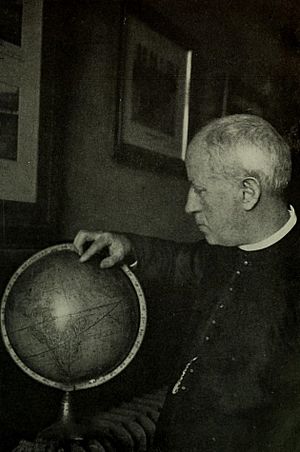José María Algué facts for kids
Quick facts for kids
José María Algué
|
|
|---|---|
 |
|
| Born | December 29, 1856 Manresa, Spain
|
| Died | May 27, 1930 (aged 73) Roquetes, Spain
|
| Occupation | Roman Catholic priest Meteorologist |
José María Algué (born December 29, 1856 – died May 27, 1930) was a Spanish Roman Catholic priest and a meteorologist. A meteorologist is a scientist who studies the weather and atmosphere. He worked at an observatory in Manila, which is a special place for observing weather and stars.
Father Algué was a member of the Society of Jesus, also known as the Jesuits. He was famous for inventing several important tools that helped people understand and predict weather.
What Did José María Algué Invent?
José María Algué invented three main scientific instruments:
- The barocyclonometer: This device was very important for predicting storms, especially cyclones or typhoons. It helped sailors and people on land know when a dangerous storm was coming. The United States Navy even used his invention on their warships around 1914!
- The nephoscope: This tool helps scientists study clouds. It allows them to measure the direction and speed that clouds are moving.
- A kind of microseismograph: This instrument is used to detect very small movements in the ground. It can help scientists learn about earthquakes or other shifts in the Earth's crust.
His Contributions to Science
Father Algué was a respected scientist. He became an honorary member of important scientific groups, like the Royal Society of London and the Pontificia Accademia Romana. This shows how much his work was valued by other scientists around the world.
He also wrote many books and articles about weather and climate, especially focusing on the Philippines. His writings helped spread knowledge about meteorology and made it easier for others to understand weather patterns in that region.
See also
 In Spanish: José María Algué para niños
In Spanish: José María Algué para niños
- List of Roman Catholic scientist-clerics

